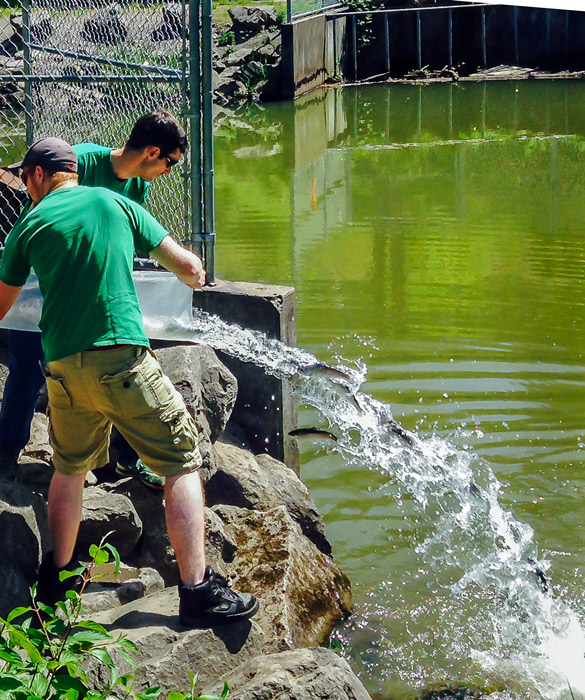Fisheries students nurture 2,500 rainbow trout from September to May

Glen Murray and Jacob Loftis, both second year fisheries students release rainbow trout in Mt. Hood’s pond.
The only collegiate fisheries program in Oregon trains 32 MHCC students each year how to conduct both hatchery and field work.
The second year of the program is predominately hatchery centered: Students receive as many as 7,000 rainbow trout eggs in September and nurture them to the legal catch size of 8 inches.
The 2,500 fish that made the cut this Spring were released into the Mt. Hood pond on May 14.
Young HeadStart students who helped care for the fish throughout the school year were on hand, said Marla Chaney, fisheries instructor: “They sprinkle feed into the fish, they get splashed and scream like crazy,” she said.
The fish will likely leave the pond at the hands of children; the annual Youth Fishing Day at Mt. Hood Pond is Saturday from 9 a.m. to 2 p.m.
Mt. Hood’s hatchery uses 95 percent re-use water (recycled on campus after cleaning). The water is reconditioned by adding oxygen and removing excess ammonia and fecal matter from the fish.
Chaney said, “It’s excellent experience for the students because water rights and water usage are becoming such a big deal. It’s really great (that) this is a water re-use facility.”
Although Chaney’s own specialty is hatchery, “We’re trying not to do just the hatchery side,” she said. “We’re trying to be a really balanced fisheries program and do the field side.”
Chaney said that in her three years at MHCC, the job has never been boring. “It’s exciting to have had 20 years working in a practical manner in hatcheries in Alaska and Oregon and trying to give that knowledge to a whole new crop of fisheries technicians,” she said.
Students’ first year is filled with field trips, led by instructor Todd Hanna.
Because the students are exposed to both hatchery and field work, “You can decide where you want to go with the degree,” said Alexis Toney, second-year student pursuing the hatchery side.
Toney had been seeking a degree in forestry at Central Oregon Community College, until students made a field trip to a hatchery research center. She got hooked, and when researching programs, found that Mt. Hood “was one of the best ones,” she said.
“There’s a ton of hands-on activities,” said second-year student John Paul Viviano, who is pursuing the field side of fisheries.
Students also learn to work with tools in a class called “building maintenance.”
“It’s a great tool to get them a job,” said Chaney. She emphasized the importance of understanding plumbing in order to enter the fisheries profession.
Graduates from Mt. Hood’s two-year program are qualified to work in fisheries with their associate of applied science degree. They qualify for a hatchery technician I position in both the Oregon and Washington departments of fish and wildlife.
In Washington, MHCC graduates also can work as a scientific technician, and in Oregon, as an experimental biological aide.
“There’s probably 70 percent of the hatchery employees (for Oregon DFW) (who) went through the Mt. Hood program here,” said Chaney.
Chaney said the fisheries program operates at just the right size, for now.
“We don’t want to increase the enrollment too much more, because we don’t want to put out too many people,” she said. “Right now we’re in sync with the amount of jobs that are happening.”
Her students say it’s a great match for their needs.
“I was looking for a community college in the area and I saw that (Mt. Hood) had a fisheries program,” said Viviano. “I kind of lucked out, to be honest. I didn’t realize it was such a good fisheries program. The instructors are super knowledgable. They have a ton of experience.”
As part of their second-year curriculum, each MHCC student must complete an individual project. Toney studied the Mollala River and examined the habitat for winter steelhead; Viviano measured the ratio of predatory and nonpredatory macro-invertebrates in four streams in the region.
Viviano is picking up a summer job as Washington Department of Fish and Wildlife, while Toney has several job prospects and may be heading for the coast.
For anyone interested in joining the fisheries program, Chaney recommends volunteering at a hatchery or regional fish and wildlife facility first to make sure the fisheries field is something they would like to pursue.

Leave a comment